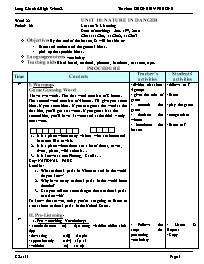Thiết kế bài dạy môn Tiếng Anh 11 - Unit 10: Nature in danger - Period: 66 - Lesson 3: Listening

Objectives: By the end of the lesson, Ss will be able to:
- listen and understand the general ideas.
- pick up the specific ideas.
Language contents: vocabulary
Teaching aids: Black board, textbook, pictures, handouts, cassette, tape.
Bạn đang xem tài liệu "Thiết kế bài dạy môn Tiếng Anh 11 - Unit 10: Nature in danger - Period: 66 - Lesson 3: Listening", để tải tài liệu gốc về máy bạn click vào nút DOWNLOAD ở trên
Week 22 UNIT 10: NATURE IN DANGER Period: 66 Lesson 3: Listening Date of teaching: Jan. 19th, 2010 Class: 11Cba, 11Cbo2, 11Cbo3 Objectives: By the end of the lesson, Ss will be able to: listen and understand the general ideas. pick up the specific ideas. Language contents: vocabulary Teaching aids: Black board, textbook, pictures, handouts, cassette, tape. PROCEDURE Time Contents Teacher’s activities Students' activities 7’ 7’ 3’ 7’ 10’ 10’ 1’ I. Warm up : Game: Guessing Word I have two words. The first word consists of 8 letters. The second word consists of 4 letters. I’ll give you some hints. If you some hints. If you can guess the word at the first hint, you’ll get 10 sweets. If you guess it at the second hint, you’ll have 5 sweets and at the third – only one sweet. It is a place where many visitors who are interested in nature like to visit. It is a place where there are a lot of forest, caves, rivers, plants, wild animals It is known as cuc Phuong, Cac Ba Key: NATIONAL PARK Lead in: What national parks in Vietnam and in the world do you know? Why have many national parks in the world been founded? Can you tell me some danger these national parks can face with? To know the answer, today you’re are going to listen to a text about national parks in the United States. II. Pre-Listening : 1. Pre – teaching Vocabulary: - scénic féatures (n) đặc trưng về thiên nhiên xinh đẹp - devásting (adj) tàn phá - appróximately (adv) xấp xỉ - véhicles (n) xe cộ - máintenance (n) sự duy trì * Checking Vocabulary: Rub out & Remember 2. Task 1 : Predicting T/ F Statements: III. While- Listening : 1. Task 1: Checking T/F: Listen to the passage and decide if the following statements are T/F. Answer: 1. T 2. T 3. F 4. T 5.T 2. Task 2 : Multiple Choice: 1. How many national parks are there in the United State? A. 50 B. 52 C. 53 D. 55 2. How many people visit national parks every years? A. five thousand B. three thousand C. millions of visitors D. billions of visitors 3. Can you name some of the problems which national parks are currently facing? A. rare animals are killed or hunted for fur, skin or other parts. B. Trees are cut down for wood. C. devasting fires are caused by careless people. D. All are correct. 4. What should be done to protect national parks? A. Increase the number of visitors to earn more money for the parks. B. These problems should be sovled gradually. C. Money should be raised for the park’s staff and maintenace of their resources. D. If there not enough money, some national parks should be destroyed. IV. Post-Listening: Discussion. have you ever visited a natioanl park in our country? Or have you ever seen a national park in Vietnam on TV? What is there National park? Does it have the same problems as the other national parks? What should we do to protect our National Parks and What shouldn’t we do to destroy them? V. Homework : - Learn by heart vocabulary. - Prepare the next lesson (Writing-p.120) - divides class into 4 groups - gives the rule of game - controls the game - declares the winner - introduces the lesson - Follows the steps for presenting vocabulary - checks - runs through - asks ss to predict the answer -ask Ss to listen to the tape twice & choose the answers - asks ss to give the answer - gives feedback. - runs through - asks ss to listen and choose the answer - asks ss to give the answer -Gives feedback. - Asks ss to work in groups and discuss the questions - Calls some ss groups - Gives the comments - asks - follows to T - listen - play the game - congratulate - listen to T - Listen & Repeat - Copy - check - listen to T - predict the answer - listen and choose the answers - Give the answer - listen and correct - listen to T - listen and choose the answer - give the answer - listen and correct - work in groups - discuss the questions - report - listen and correct - listen
Tài liệu đính kèm:
 UNIT10-LISTENING-LOP 11.doc
UNIT10-LISTENING-LOP 11.doc





